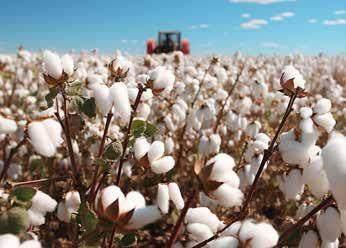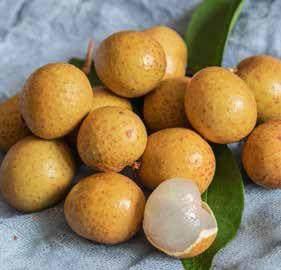二十四节气之白露和秋分The 24 Solar Terms
何芷翌 He Zhiyi



白露Bailu
白露是二十四节气中的第15个节气,也是秋季六个节气中的第三个节气,发生在9月7日~ 9日之间,表示仲秋开始。白露,意为露凝为白。《诗经》有云:“ 蒹葭苍苍,白露为霜。”这是一年中温差最大的时节,夏季风和冬季风在此时激烈交锋。夜晚空气中的水汽凝结成的露珠晶莹剔透,在晨光的照射下发出耀眼洁白的光芒,所以被称为“白露”。
Bailu, or White Dew, is the 15th solarterm in the 24 solar terms, and the 3rdsolar term in the six solar terms of autumn,occurring between September 7th and 9th,marking the start of mid-autumn. Bailu refersto dew condensing into white frost. A poem inthe Book of Songs goes: “The reeds so lush andgreen, the white dew becomes frost.” This seasonwitnesses the greatest temperature differentialall year as summer winds clash intenselywith winter winds. Moisture in the night aircondenses into translucent dewdrops that shinedazzlingly bright white under the morning light,hence the name Bailu (White Dew).
白露时节也是收获的季节——秋收作物成熟,瓜果丰实。俗话说:“ 白露秋分夜,一夜冷一夜。”这个时节多吹偏北风,冷空气南下逐渐频繁,加上太阳直射地面的位置南移,使得北半球日照时间变短,日照强度减弱,夜间常晴朗少云,地面辐射散热快,因此气温下降也逐渐加速。
The season of Bailu is also harvestingtime — autumn crops ripen, and fruitsand melons grow abundant. A saying goes:“The nights after White Dew and AutumnEquinox grow colder and colder.” Coolnortherly winds begin blowing frequently atthis time as cold air moves south. Coupledwith the sun shifting to shine directly furthersouth of the Northern Hemisphere, daylighthours grow shorter, and sunlight intensityweakens. Night skies are often clear with fewclouds, and the ground quickly radiates anddissipates heat. Hence temperatures drop atan accelerating pace.
白露既是收獲的季节,也是播种的季节。东北平原开始收获谷子、大豆和高粱,华北地区秋季农作物成熟,大江南北的棉花正在吐絮,全国进入全面分批采收的农忙时期。西北、东北地区的冬小麦开始播种,华北的秋种也即将开始。黄淮地区、江淮及以南地区的单季晚稻已扬花灌浆,双季双晚稻即将抽穗。
Bailu is both a harvest season and a sowingseason. In Northeast Chinas plains, millet, soybeans,and sorghum harvesting has commenced, whileautumn crops in North China are maturing. Cottonbolls across the country are bursting as full-fledgedgraded picking enters its busy season. Winter wheatsowing begins in Northwest and Northeast China,while North Chinas autumn sowing will start soontoo. Single-season late rice in the Huang-HuaiRegion (ranging from the south of the Yellow Riverthrough the north of the Huai River), along withareas around and south of the Jiang-Huai Region(spanning from the south of Huai River to the northof the Yangtze River), has already flowered andripened, while double cropping late rice is soon tohead.
一提到白露,爱喝茶的人定会想到“白露茶”。白露时节,是酷热夏季之后茶树生长的极好时期。白露茶不像春茶那样鲜嫩,也不像夏茶那样干苦,而独有一种甘醇的清香,备受品茶爱好者的青睐。此外,中国南方一些地区还会用糯米、高粱等谷物酿米酒,其酒味甘醇、营养丰富,是秋季招待客人的佳酿。
When Bailu arrives, tea enthusiasts undoubtedlyassociate it with “Bailu tea.” This season marks theprime growth period for tea trees after the scorchingsummer. Unlike the tenderness of spring tea orthe dry bitterness of summer tea, Bailu tea boastsa uniquely mellow and fresh fragrance, cherishedby connoisseurs. In certain regions of South China,glutinous rice, sorghum, and other grainsare utilized to craft sweet and nourishingautumnal rice wine, a delightful beveragefor hosting guests.
除了喝白露茶,白露還是吃龙眼的最佳时节。有俗话说:“ 白露吃龙眼,一颗顶只鸡。”尤其是在中国东南地区,吃龙眼的习俗由来已久。因龙眼有益气补脾、养血安神等多种功效,可以治疗贫血、失眠、神经衰弱等多种疾病,福州人便喜爱在白露这一天买龙眼吃。老福州人喜欢将剥了皮的龙眼泡在稀饭里,龙眼晶莹剔透,孩子们可以为此多吃一碗饭。
In addition to indulging in Bailu tea,the season of Bailu is the prime time forsavoring longan fruit. A popular sayingemphasizes the significance of consuminglongans during this period: “Eatinglongans on White Dew, one piece equals awhole chicken.” This tradition, particularlyprevalent in Southeast China, has deeproots. Longans are not only delicious butalso rich in nutrients that nourish thespleen, blood, and spirit. They offer varioushealth benefits, including alleviatinganemia, relieving insomnia, and treatingneurosis. In Fuzhou, locals have a specialaffinity for purchasing longans to enjoyon this day. Older Fuzhou residents, inparticular, have a delightful practice ofsoaking peeled longans in rice porridge,enhancing the dishs appeal for childrenwho would enjoy an extra bowl because of them.
二十四节气秋分The 24 Solar Terms
秋分Qiufen
秋分是二十四节气中的第16个节气,恰好处于秋天的中段。顾名思义,“秋分”就是秋天的一半,“平分秋色”一词也由此得来。秋分发生在每年9月22日~ 24日之间。此时,太阳直射点回到赤道,又一次把光线和热量平分给南北半球,所以在这一天,南北半球的白天和夜晚都一样长。过了这一天,北半球的夜晚就开始慢慢变得比白天长。秋分时节,长江流域及其以北地区先后进入秋季,日平均气温降到22℃以下。而大部分地区雨季已经结束,凉风习习,碧空万里,秋高气爽,丹桂飘香,蟹肥橘黄,美好宜人。看万山红遍,层林尽染,带走初秋的淡雅,迎来深秋的斑斓。
Qiufen, or the Autumnal Equinox, the16th solar term in the 24 solar term, occurs inmid-autumn, specifically between September22nd and 24th each year. True to its name,Qiufen signifies the midpoint of autumn,leading to the poetic notion of “evenly splitautumn hues.” During this period, the sunreturns to the celestial equator, distributingsunlight and heat evenly between the Northernand Southern Hemispheres. Consequently,both hemispheres experience equal day andnight length on this day. Following Qiufen,the Northern Hemisphere witnesses nightsgradually lengthening compared to the days.In regions along the Yangtze River and farthernorth, autumn takes hold during the equinoxseasons, characterized by average temperaturesbelow 22°C. The conclusion of most regionsrainy seasons ushers in refreshing cool breezes and expansive blue skies, creating an invigoratingearly autumn. The sweet fragrance of osmanthuspermeates the air while crabs plump up andoranges transition to a vibrant yellow — a delightfulprelude to the visually stunning mid-autumn. Thelandscape transforms into a spectacle of reddeningmountains and forests, exhibiting the exquisitetransition from early autumns gentle elegance tomid-autumns vibrant splendor.
由于秋分后降温加快,“三秋”(即秋收、秋耕、秋种)大忙显得格外紧张。秋分时节,棉花吐絮,烟叶也由绿变黄,正是收获的黄金时机。华北地区已经开始播种冬小麦,长江流域及南部广大地区正忙着收割晚稻,抢晴耕,翻土地,准备耕种油菜。秋分时节的干旱少雨或连绵阴雨是影响三秋正常进行的主要不利因素,特别是连绵阴雨会使即将成熟的农作物倒伏、霉烂或发芽,造成严重损失。三秋大忙,贵在“早”字——及时抢收农作物可使其免受早霜冻、连阴雨的危害,适时早播冬季农作物可争取利用冬前的热量资源,培育壮苗安全越冬,为来年收获奠定丰产的基础。
Following Qiufen, the intensification of postequinoxcooling adds urgency to the bustlingagricultural activities called “the three autumns” —autumn harvest, autumn plowing, and autumnsowing. This juncture marks the golden period forharvesting as cotton bolls burst open, and tobaccoleaves transition from green to yellow. North Chinahas initiated winter wheat planting, while regionsalong the Yangtze River and further south raceagainst time to reap late rice while simultaneouslyplowing and preparing for oilseed rape sowing.However, the precarious balance of weather duringthis season, featuring droughts or prolonged rain,poses challenges to the routine farm work of the three autumns. Extended rainfall, inparticular, risks flattening, molding, orprematurely sprouting crops that areon the verge of ripening. Successfullymanaging these critical farming taskspivots on timing — timely harvests preventdamage from early frost and rain, whileearly sowing of winter crops allowsthem to make use of pre-winter warmth,fostering robust seedlings and ensuringabundant harvests in the coming year.
到了秋分,中秋節便不远了。农历八月十五是中国传统的中秋佳节,也被称为“团圆节”,是家人团圆的日子。中秋夜,圆月当空,与家人一起品饼赏月;即便家人不能团聚,皎皎明月也寄托着人们的思乡之情。月饼是古代中秋祭拜月神的供品,圆圆的月亮象征着阖家团圆,月饼自然就成为这一节日必备的美食。
The arrival of Qiufen signals the onsetof the Mid-Autumn Festival. Celebratedon the 15th day of the eighth lunarmonth, this traditional Chinese festival,also known as the “Reunion Festival,” isa time dedicated to family gatherings.Against the backdrop of the full harvestmoon, families come together to sharemooncakes, fostering a sense of unity.Even when they are separated, the samemoon connects individuals yearning forhome. Mooncakes, originally offered tothe lunar deity in ancient mid-autumnrituals, feature a round shape symbolizingfamily togetherness, making them anemblematic delicacy for this festiveoccasion.

